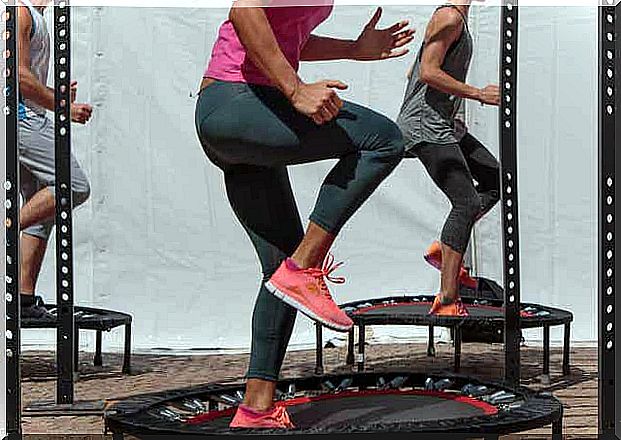Stagnation Or Plateaus In Bodybuilding Routines

Training plans often start perfectly and cause accelerated muscle growth in the first phases. However, after a few months of great results, the beneficial changes tend to slow to a halt. This lack of physical evolution in the application of normal exercise is what is known as stagnation or plateaus.
The stalling of muscle development can have a demotivating effect for many people, so it is essential to make immediate adjustments to overcome the problem. To be successful, of course, you need to understand how muscles work in this process and develop strategies to break through the adverse adaptation. Read on to discover solutions to this problem.
Why does muscle growth slow down?
For starters, the satisfying variations in muscle hypertrophy and strength that occur during the first few training sessions are due to the body receiving a new stimulus. As the number of sessions increases, the muscles gradually adapt.
So there comes a point where the accustomed muscles no longer require significant effort to do the routine and no longer perceive that extra load that stimulates growth. In addition, imbalances in the training-recovery relationship are also fundamental when it comes to stagnation or plateaus in bodybuilding routines.
The main sign that a plateau has been reached in our physical fitness is how easy it becomes to complete sets. Therefore, week after week, you need to be alert to your body’s reaction and the feeling of stagnation. Monotony in the sequence of exercises is the central reason why muscles reduce or stagnate their growth.
Other Factors That Change Exercise Routine

This lack of progress is due not only to training without variation over time, but also to multiple external factors. With that in mind, we’ll describe how factors such as diet, sleep deprivation, stress, and poor recovery can affect your hard work in the gym.
Eating problems
A poorly structured diet can be the reason for lower muscle growth after training. You have to make sure that the ratio between proteins and carbohydrates is well distributed.
In that sense, it is important to keep proteins within a margin of between 0.8 and 2.5 grams per kilogram of body weight. An increase in protein consumption is safe, according to studies published in the United States National Library of Medicine . However, you should also consume between 5 and 10 grams of carbohydrates per kilogram of body weight per day.
Lack of sleep
Respecting the number of hours of sleep your body needs makes an immense contribution to keeping your muscles in good shape. Why is that so important? Well, because about 80% of the production of growth hormones takes place during the rest period.
Excessive Stress
The adverse effects of stress are well known, and these also include adverse effects on the various muscle groups in your body. Simply put, stress can increase cortisol levels. This change can affect muscle growth by promoting the following effects:
- Increased appetite.
- Increased fat accumulation.
- breakdown of proteins.
- Promotion of catabolism.
Poor recovery
Overexertion is another factor that affects stagnation or plateaus in bodybuilding routines. It occurs when certain parts of the body are exposed to training with insufficient rest breaks, leading to fatigue that reduces performance.
To counteract this, it is recommended to put less stress on the body. That means you need to lower the intensity of the physical activity for a certain period of time. This allows sufficient time for the recovery of maximum power. By reducing the load every 6 to 8 weeks, you can avoid a plateau.
How do you stop stagnation or plateaus in bodybuilding routines?

If stagnation in your bodybuilding routine has become a long-term complication, you need to vary your exercise routine significantly. In addition, you should include the following tips when setting up your schedule. Implement these strategies!
Use short exercise schedules
Plan several routines that you can alternate so that the implementation of each routine does not take more than 3 months. In order not to fall into stagnation or plateaus, apply a 4 to 6 week exercise cycle, maintaining a regular rotation. Only in this way can the muscles receive sufficient new stimuli.
Adjust the reps to avoid stagnation or plateaus in your routines
Changing reps and loads regularly is a helpful measure. How can you do this? By alternating. That is, if you regularly choose 4 sets of 8 reps, change that and start doing, say, 5 sets of 6 reps.
Stimulate your muscles in advance
Stimulation of the muscles, prior to the most demanding work, is crucial to achieve sustained muscle growth. To do this, it is good to do some repetitions intermittently, but reduce the load on the exercise itself. This produces better results when you want to achieve changes in isolated muscles.
Increase your overall speed to avoid stagnation or plateaus in your bodybuilding routines
Overall execution speed is a great ally to end stagnation or plateaus in bodybuilding routines. It’s very easy to incorporate this tip into your routine. You just need to do the reps in a fraction of the time you usually do them. As a result, you generate new stimuli that provide improvements in strength and size.
Provide a series of exercises
The number of exercises you consider should be varied, because the idea is that the muscles don’t get used to one particular workout. With this in mind, you should divide the exercises into standard (immutable) and rotating (variable) categories.
This facilitates the task of reorganizing activities to avoid stagnation in bodybuilding routines. Of the standard options, you can consider the following exercises:
- bench press
- Deadweight Exercises
- free squat
You can avoid stagnation or plateaus in your bodybuilding routines
Finally, we would like to note that modifying the execution of the exercises produces noticeable effects in favor of different stimuli that avoid the risk of stagnation or plateaus in bodybuilding routines. Also, changes need to be made regarding your preferred technique.
In addition, supplements are good alternatives to increase the speed of recovery by absorbing nutrients that are lacking in the diet. Before taking them, however, you should consult a specialist to evaluate the demands of your routine and the results you desire.









